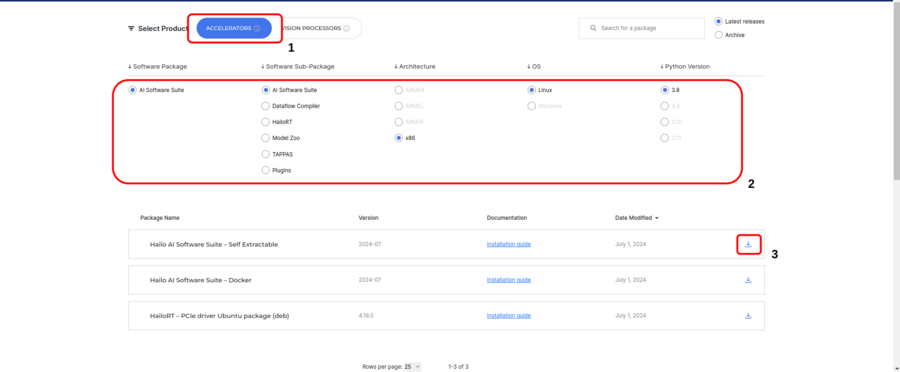Hailo AI Software Suite Installation
Introduction
The Hailo AI Software Suite consists of a comprehensive set of frameworks and tools designed for compiling, running, and evaluating neural networks on Hailo devices:
- Dataflow Compiler: Converts and compiles models into the Hailo binary format.
- HailoRT: Provides the runtime environment and driver for executing networks and interacting with Hailo devices.
- Model Zoo: Contains pre-trained models for running and evaluating on Hailo devices.
- TAPPAS: Offers a deployment framework, examples, and multi-network pipelines.
While each component can be installed individually, Hailo releases a quarterly software suite that aligns all product versions. Using the Hailo AI Software Suite ensures optimal compatibility.
Hailo AI Software Suite Components
In the Model Build Environment:
- Hailo Dataflow Compiler: Compiles trained models into a format suitable for execution on Hailo devices.
- Hailo Model Zoo: Provides a comprehensive database of pre-trained models optimized for Hailo devices, along with a retraining environment.
In the Runtime Environment:
- HailoRT: Loads compiled models onto Hailo devices and facilitates interaction through the PCIe driver.
- TAPPAS: Includes detailed examples and demonstrations for utilizing HailoRT to create and manage full pipelines on Hailo devices.
For more information about the Hailo AI Software Suite, you can read the following wiki: Hailo AI Software Suite.
Installation
The Hailo Software Suite can be installed in three ways:
- Using the all-in-one Docker file
- Using the all-in-one self-extracting executable
- Manual installation of the packages in a defined order
- Evaluation Board: PCIe interface or Gigabit Ethernet (802.3) interface
- M.2 Board: M.2 connector (*)
- mPCIe Board: mPCIe connector
(*) This guide was developed using the Hailo-8 M.2 AI Acceleration Module.
System Requirements
The following requirements are needed for the installation:
- Operating System: Ubuntu 20.04/22.04, 64-bit
- Memory: 16+ GB RAM (32+ GB recommended)
- Python: Python 3.8/3.9/3.10, including pip and virtualenv
- Packages:
- python3.X-dev and python3.X-distutils (according to the Python version)
- python3-tk, libfuse2, graphviz, and libgraphviz-dev (install with sudo apt-get install PACKAGE)
- build-essential (needed for compiling the PCIe driver)
- For TAPPAS: ffmpeg, x11-utils, python-gi-dev, libgirepository1.0-dev, libzmq3-dev, gcc-9, and g++-9
- git, opencv4, gstreamer, pygobject, opencv_flann, calib3d, and features2d
- Optional: bison, flex, libelf-dev, and dkms (needed to register the PCIe driver using DKMS)
- Optional: cmake (needed for compiling the HailoRT examples and for the TAPPAS installation when using the self-extracted executable)
Install System Requirements
Install Essential Packages
sudo apt-get install build-essential
Install Python and Development Tools
Replace `X` with the version of Python you are using (e.g., 3.8, 3.9, or 3.10).
sudo apt-get install python3.X python3.X-dev python3.X-distutils python3-tk python3-pip python3-venv
Install Additional Required Packages
sudo apt-get install libfuse2 graphviz libgraphviz-dev
Install Packages for TAPPAS
sudo apt-get install -y ffmpeg x11-utils libgstreamer-plugins-base1.0-dev python-gi-dev libgirepository1.0-dev libzmq3-dev gcc-9 g++-9
Install GStreamer
sudo apt-get install libgstreamer1.0-dev libgstreamer-plugins-base1.0-dev libgstreamer-plugins-bad1.0-dev gstreamer1.0-plugins-base gstreamer1.0-plugins-good gstreamer1.0-plugins-bad gstreamer1.0-plugins-ugly gstreamer1.0-libav gstreamer1.0-tools gstreamer1.0-x gstreamer1.0-alsa gstreamer1.0-gl gstreamer1.0-gtk3 gstreamer1.0-qt5 gstreamer1.0-pulseaudio
Packages for PCIe Driver and DKMS
sudo apt-get install bison flex libelf-dev dkms
Install CMake
sudo apt-get install cmake
Install OpenCV
Download Opencv and unzip
wget https://github.com/opencv/opencv/archive/4.5.2.zip unzip 4.5.2.zip
cd and make build dir
cd opencv-4.5.2 mkdir build cd build
Make and install
cmake -DOPENCV_GENERATE_PKGCONFIG=ON \
-DBUILD_LIST=core,imgproc,imgcodecs,calib3d,features2d,flann \
-DCMAKE_BUILD_TYPE=RELEASE \
-DWITH_PROTOBUF=OFF -DWITH_QUIRC=OFF \
-DWITH_WEBP=OFF -DWITH_OPENJPEG=OFF \
-DWITH_GSTREAMER=OFF -DWITH_GTK=OFF \
-DOPENCV_DNN_OPENCL=OFF -DBUILD_opencv_python2=OFF \
-DINSTALL_C_EXAMPLES=ON \
-DINSTALL_PYTHON_EXAMPLES=ON \
-DCMAKE_INSTALL_PREFIX=/usr/local ..
make -j4
sudo make install
Update the linker
sudo ldconfig
Install pygobject
sudo apt install python3-gi python3-gi-cairo gir1.2-gtk-3.0
Download the Hailo Software Suite
To download the Hailo Software Suite, follow these steps:
- Visit Developer Zone/Software Downloads.
- Select the "Hailo AI Software Suite – Self Extractable" option, as illustrated in the image below.

Installing Hailo AI Software Suite
Once you have downloaded the "Hailo AI Software Suite – Self Extractable", you will have a file named hailo_ai_sw_suite_<version>.run
- Move this file to the directory where you want to have the installation files.
- Open a terminal window and run the following command to make the file executable:
Replace <version> with the specific version number of the file you downloaded.
sudo chmod 770 hailo_ai_sw_suite_<version>.run
- To install the Hailo AI Software Suite, execute the following command in your terminal:
Replace <version> with the specific version number of the file you downloaded.
./hailo_ai_sw_suite_<version>.run
- When the installation begins, you will see text similar to the following in your console:
omendez@ridgern-G5-5587:~/Documents/hailo-dirs$ ./hailo_ai_sw_suite_2024-07.run Creating directory hailo_ai_sw_suite Verifying archive integrity... 100% MD5 checksums are OK. All good. Uncompressing Hailo-AI-SW-Suite-Installer 100% Starting Hailo AI Software Suite installation INFO: Checking system requirements... WARNING: It is recommended to have 32 GB of RAM, while this system has only 30 GB. INFO: System requirements check finished successfully.
- When the installation is complete, you will see output similar to the following:
Hailo SW Bundle installed successfully Please reboot the machine
Activating the Virtual Environment
After the installation is complete, activate the newly created virtual environment by running:
source hailo_ai_sw_suite/hailo_venv/bin/activate

